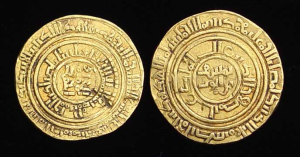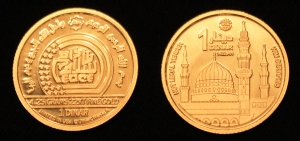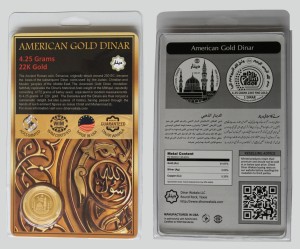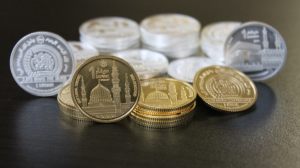Dinar Wakala LLC, an alternative bartering solution provider based out of Austin Texas, has launched its newest medallion, the American Gold DinarTM, completing its portfolio of precious metals based tokens targeted primarily to the sound money enthusiasts in the Muslim community, as well as to the broader audience of numismatic collectors and bullion investors.
The medallion retains the primary design features of a predecessor in its series, the American Silver DirhamTM, featuring an artistic amalgamation of the Middle Eastern symbol of the Rub-el-Hizb with the stars and stripes from the US flag, a combination that faithfully depicts the cross-civilizational partnership underlying the production of the medallion itself. It is the result of collaboration between the Dallas based American Open Currency Standard (AOCS), Dinar Wakala LLC and Emir Ismail Bryant, representing the Muslim communities of North Carolina and Philadelphia.
AOCS is a sound money movement started in the US to establish an honest value-for-value trading standard. AOCS has worked with communities and groups around the world to aid in the development of private trading medallions and guarantee that they conform to a verifiable standard. The American Silver Dirhams and Gold Dinars are the latest addition to their catalog which includes designs for the Ludwig Von Mises institute, Ron Paul's Campaign for Liberty and the sovereign Lakota Nation with whom they co-founded the Free Lakota Bank. Their web site is www.opencurrency.com.
On the other hand, sound money activists in the Muslim community have also been active for over a decade, hailing from both the grassroots, as well as from the Academia, which comes with its scholarly criticism to the Islamic Banking industry. The Gold Dinar as a community medium of exchange, in contrast to traditional Islamic Banking, draws its primary inspiration and religious sanction from the sacred texts of the Quran and the Sunnah. The Dinar and the Dirham, being the currencies of the 7th Century Arabia, are directly mentioned in the Quran and Hadith literature, and figure prominently in the Fiqh jurisprudence governing charity and Zakat-based religious taxation. Additionally, the depth of Muslim’s cultural association with the coin is also obvious by its pervasive historical presence as the uniform currency in the Muslim world. The Dinar derives its name from the Roman Denarius struck around 200 BC, and it subsequently came into use among the Judaic, Christian and Muslim peoples of the Middle East. The Dinar is based on the historical weight measurement of the Mithqal, reputedly consisting of 72 grains of barley seed. Starting from Islam's first city-state in Madina, the Dinars and Dirhams were used as currency in the Muslim world, down to the Ayyubid and more lately, Ottoman empires. Sound money advocates in the Muslim world thus find history and cultural tradition at their side when lobbying in their countries for a return to bullion backed currency.
However, the strongest case for its revival in the modern world runs not on a cultural, but a legal precept in Islamic Finance: The twin prohibition of Riba and Gharar. So while the Austrian Economists criticize central banking from an economical and ethical view point, Islam lends support to the same conclusions on legal footings. The prohibition of usury (Riba) forbids the discounted sale of debt by the Treasury to the Central Bank, and the prohibition of uncertainty (Gharar) forbids the increase in money supply by way of fractional reserve banking. Taken together, the two injunctions provide grounds for Dinar activists to demand monetary and banking reforms along similar lines to those popularly expressed in their own times by Thomas Jefferson and Andrew Jackson. "Long before even starting this initiative”, in the words of Asif Shiraz, the Pakistani American founder and CEO of Dinar Wakala LLC, “I realized the strong congruence that existed between what has been handed down to the Americans by their founding fathers like Jefferson, and to us, by the Imams of Fiqh. It was one and the same thing, at least from a strictly economic perspective: A free market economy, denominated in sound money, with limited government interference. This was a great Eureka moment! That our civilizations are much closer to each other in values, than what appears at first glance from the politically tainted milieu of conflict. From that time on, this singleness of purpose, to collaborate on restoring sound money, has brought me closer to my libertarian friends in America, far more effectively than any number of interfaith conferences or cultural events."
Another distinctive feature of these medallions is their certification by the WIM - The World Islamic Mint (www.islamicmint.com), which serves to verify compliance with legal standards in accordance with Islamic law during the manufacture of coins and medallions. Correctly manufactured products receive a corresponding license from WIM, which greatly facilitates their exchange at par value, even if manufactured in different parts of the world. The American Gold DinarTM will join their existing line up of the much coveted Kelantan Dinar, issued by the Government of the Malaysian State of Kelantan, whose launch last year was noted by the Wall Street Journal as "the forming of Utopia for the world’s gold bugs".

A Gold Dinar of the Ayyubid Sultan Saladin circa 1193
Following the terrible tragedy of 9/11, the Gold Dinar was also caught in an impulsive surge of suspicion surrounding all things Middle Eastern, with some analysts misunderstanding its resurgence as being associated with some extremist philosophy. However, as the temperatures have cooled off and the demand for sound money, or at least some prudence in monetary policy, is now a mainstream debate topic, the Gold Dinar is also regaining its stature in the US as a novel avenue for bullion investment. According to Craig Smith, Chairman of the Swiss America Trading Corp. and author of Rediscovering Gold in the 21st Century, "[the] Dinar is a brilliant approach to a world awash with Fiat currencies and Muslims who use the dinar for savings and future buying power will be rewarded." But doing beyond that, as a medium of exchange rather than just an investment instrument, the struggle still continues. Despite active lobbying, the Gold Dinar is not the legal tender of any Muslim country, although the adoption in Kelantan has caused many rulers of other dominions in the Far East to open up dialogue with Umar Ibrahim Vadillo. According to statistics issued by the Kelantan Golden Trade organization, there are over 3000 shops that accept the Dinar, and coins worth over 12 million USD have been issued. The former Prime Minister of Malaysia, Tun Dr Mahathir Mohamad has himself been an avid supporter of the Gold Dinar even while in office, and considers it an instrument for ending currency wars if employed for settlement of international trade.
Whether or not the Gold Dinar is ever able to do that is yet to be seen. In the mean time, however, it is definitely expected to be a welcome addition to numismatic collections the world over. The medallion can be ordered online from the company website at www.dinarwakala.com.
About Dinar Wakala LLC. The company is located in Round Rock, Texas and is the only US body certified by the World Islamic Mint (WIM) to produce medallions conforming to their standard. The company aims to establish an online precious-metal based barter exchange called GoldMoneyShop.com, and is developing its own medallions to be used as dollar-denominated barter tokens on the platform.
source : http://www.dinarwakala.com/Media/Index/2011-12-06_Launch_Of_The_American_Gold_Dinar



